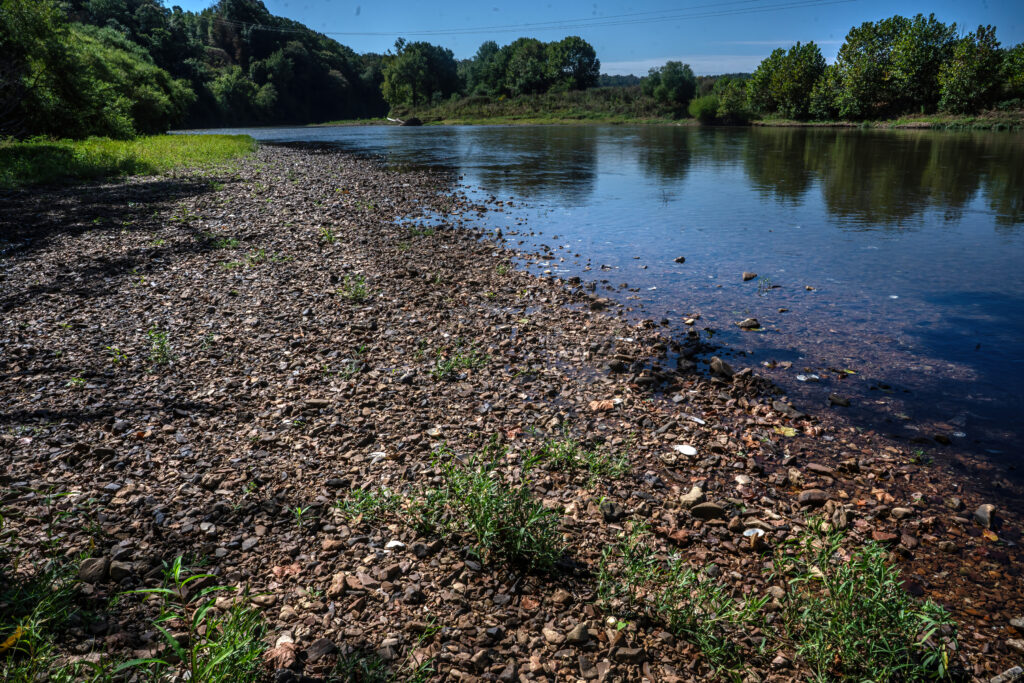
A bank of dry rocks and dead mussel shells shows how far the water level of the Duck River has receded in Centerville, Tenn. (Photo: John Partipilo/ Tennessee Lookout)
After years of advocacy from conservation groups, Gov. Bill Lee on Wednesday signed an executive order aiming to protect the Duck River, the longest and most biodiverse river in Tennessee.
The scenic 269-mile waterway is renowned for hosting the largest variety of living organisms of any freshwater river in North America. But the Duck was named the third-most endangered river in the nation by nonprofit environmental organization American Rivers this year due to the threat of “excessive water withdrawals” as utility companies seek to extract millions more gallons of water to supply Middle Tennessee’s fast-growing population.
“As we continue our work to balance Tennessee’s economic growth with a plan to protect our environment, preserving waters like the Duck River and enhancing water resource management statewide will be a cornerstone of our long-term conservation strategy,” Lee stated in a news release.
The order creates a partnership charged with forming watershed management recommendations that protect the river’s health as the region’s freshwater needs rise. The new 19-member Duck River Watershed Planning Partnership will also identify ways to manage drought, reduce water loss, preserve habitats and engage with local communities, utilities and industries.
The order also lays out directives for the Tennessee Department of Environment and Conservation, which issues permits to utilities withdrawing water from the river. Lee’s administration will bring budget requests to the Tennessee General Assembly in January to fund the creation of a statewide water conservation plan and a plan specifically addressing the Duck River, the order states.
Environmentalists: Drought, water withdrawal tax river
The Duck River is the sole water source for at least 250,000 Tennesseans. Extreme drought conditions this summer drove flows in the Duck River to record lows, according to the Southern Environmental Law Center (SELC), putting the river and the dozens of species it supports in peril.

“Along with its natural beauty and incredible wealth of wildlife, the Duck River is the backbone of local economies throughout Middle Tennessee,” SELC Director George Nolan stated in a news release. “While there is still much work to be done, this order gets us closer to ensuring that both the river and nearby communities can continue to thrive for years to come.”
The SELC is appealing three permits issued by TDEC, including a permit for a new withdrawal site on the Maury-Hickman county line, seeking stricter protections. Eight utilities want to withdraw up to 73 million gallons from the river each day, 19 million gallons more than today’s limit.
The permits granted as of October allowed utilities to lose up to 25% of the water they withdraw from the river, a pain point for environmental groups and residents who live near the river. Lee’s executive order instructs TDEC to cap water loss reduction goals at 20%, but states the goals are not meant to be “punitive” but rather “to incentivize reduction of leaks and wasted water.”
The SELC points to the recent death of hundreds of freshwater mussels — which filter river water and are used as “harbingers” for river health — as a sign the river is struggling. Freshwater mussel expert Don Hubbs found 565 dead mussels at locations from Shelbyville to Columbia in July, including remains of nine federally protected endangered species.
Lee’s order states TDEC will continue developing a Habitat Conservation Plan that will specifically include “measures to avoid, minimize and mitigate impacts to endangered mussel species” and work with the Tennessee Wildlife Resources Agency’s freshwater mussel propagation program.
Environmental groups including the SELC, The Nature Conservancy, the Tennessee Wildlife Federation, the Harpeth Conservancy and the Duck River Conservancy advocated for TDEC to lead the creation of a regional drought management plan, a task currently overseen by the Duck River Development Agency. The agency was created in 1965 to steer development along the river, and is funded by payments from water utilities based on the number of gallons the utilities sell to customers.

Under the executive order, TDEC will collaborate with the Duck River Development Agency to support its management of the river’s water resources. The department will also collaborate with the agency and others to shape a regional drought management plan that will be reviewed each decade.
Other directives for the department include:
- Prioritizing regionalization to limit the number of withdrawal points on sensitive portions of the Duck River while maintaining a stable water supply for consumers
- Working with other agencies to expand public education about why protecting watersheds is important
- Improve recreational access to the Duck River while protecting the river from overuse
- Collaborating with the Tennessee Valley Authority to update the Normandy Reservoir Management Plan to improve flood control and drought management using modeling from the U.S. Army Corps of Engineers
- Vett large-scale engineering plans for drought mitigation, sustainability, cost, and feasibility before presenting to the governor
- Identify other watersheds that could benefit from similar protections
- Continue statewide water planning with an eye toward regionalization and collaboration between utilities
- Support cities’ wastewater treatment optimization to reduce pollution from nitrogen and phosphorus
- Work with other entities on a program to restore vegetation on riverbanks
- Provide support for nature-based flood, stormwater and runoff management
“We are heartened that the Order acknowledges the crucial role that both water use and land management will play in this endeavor,” Nolan told Tennessee Lookout. “Governor Lee’s Order highlights the need for nature-based stormwater controls, smart urban development, and sustainable agricultural practices. We look forward to working with TDEC and the Governor’s office to explore additional land use practices that should be prioritized to protect this invaluable watershed.”

